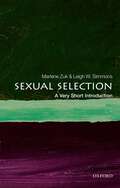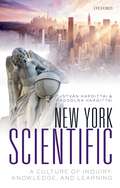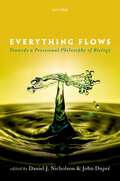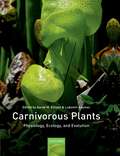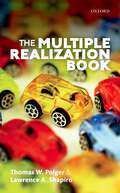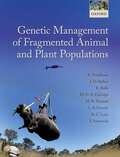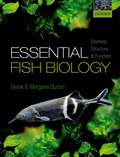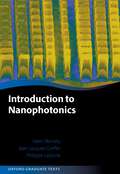- Table View
- List View
Theory-Based Ecology: A Darwinian approach
by Liz Pásztor Zoltán Botta-Dukát Gabriella Magyar Tamás Czárán Géza MeszénaEcology is in a challenging state as a scientific discipline. While some theoretical ecologists are attempting to build a definition of ecology from first principles, many others are questioning even the feasibility of a general and universal theory. At the same time, it is increasingly important that ecology is accurately and functionally defined for a generation of researchers tackling escalating environmental problems in the face of doubt and disagreement. The authors of Theory-Based Ecology have written a textbook that presents a robust, modern, and mathematically sound theory of ecology, maintaining a strong link between empirical data, models, and theory. It is firmly based in Darwinian thought, since it was Darwin who first revealed the ecological principles of the origin of species, and gave the evolution of diversity a process-based, mechanistic explanation. The authors base their synthetic theory of Darwinian ecology on seven key principles: exponential growth, growth regulation, inherited individual differences, finiteness and stochasticity, competitive exclusion, robust coexistence, and constraints and trade-offs. Within this solid conceptual framework, they integrate classic and actual empirical knowledge from ecology and evolutionary biology, clarifying methodological and mathematical detail in clear and helpful text boxes. A wealth of illustrated examples pertaining to different organisational levels (alleles, clones and species) helps to explain how the principles operate. This is an invaluable resource for graduate level students as well as professional researchers in the fields of ecology, genetics, evolutionary ecology, and mathematical biology.
Sexual Selection: A Very Short Introduction (Very Short Introductions)
by Marlene Zuk Leigh W. SimmonsWhat is responsible for the differences between the sexes in so many animals, from the brilliant plumage of birds of paradise to the antlers on deer? And why are the traits that distinguish the sexes sometimes apparently detrimental to survival? Even when they look more or less alike, why do males and females sometimes behave differently? Questions like these have intrigued scientists and the public alike for many years, and new discoveries are showing us both how wildly variable the natural world is, and how some basic principles can help explain much of that variation. Like natural selection, sexual selection is a process that results from differential representation of genes in successive generations. Under sexual selection, however, the crucial characteristics that determine whether an individual reproduces depend on sexual competition, rather than survival ability. This Very Short Introduction considers the history of our understanding of sexual selection, from Darwin's key insights to the modern day. Considering the investment animals place on reproduction, variation in mating systems, sexual conflict, and the origin of sexual dimorphism, Marlene Zuk and Leigh Simmons discuss questions such as whether females can really choose between males on aesthetic grounds, and how sexual conflict is resolved in different species. They conclude with a consideration of the thorny question of how, and even if, sexual selection theory applies to humans. ABOUT THE SERIES: The Very Short Introductions series from Oxford University Press contains hundreds of titles in almost every subject area. These pocket-sized books are the perfect way to get ahead in a new subject quickly. Our expert authors combine facts, analysis, perspective, new ideas, and enthusiasm to make interesting and challenging topics highly readable.
Sexual Selection: A Very Short Introduction (Very Short Introductions)
by Marlene Zuk Leigh W. SimmonsWhat is responsible for the differences between the sexes in so many animals, from the brilliant plumage of birds of paradise to the antlers on deer? And why are the traits that distinguish the sexes sometimes apparently detrimental to survival? Even when they look more or less alike, why do males and females sometimes behave differently? Questions like these have intrigued scientists and the public alike for many years, and new discoveries are showing us both how wildly variable the natural world is, and how some basic principles can help explain much of that variation. Like natural selection, sexual selection is a process that results from differential representation of genes in successive generations. Under sexual selection, however, the crucial characteristics that determine whether an individual reproduces depend on sexual competition, rather than survival ability. This Very Short Introduction considers the history of our understanding of sexual selection, from Darwin's key insights to the modern day. Considering the investment animals place on reproduction, variation in mating systems, sexual conflict, and the origin of sexual dimorphism, Marlene Zuk and Leigh Simmons discuss questions such as whether females can really choose between males on aesthetic grounds, and how sexual conflict is resolved in different species. They conclude with a consideration of the thorny question of how, and even if, sexual selection theory applies to humans. ABOUT THE SERIES: The Very Short Introductions series from Oxford University Press contains hundreds of titles in almost every subject area. These pocket-sized books are the perfect way to get ahead in a new subject quickly. Our expert authors combine facts, analysis, perspective, new ideas, and enthusiasm to make interesting and challenging topics highly readable.
New York Scientific: A Culture of Inquiry, Knowledge, and Learning
by István Hargittai Magdolna HargittaiThis book introduces the reader to the visible memorabilia of science and scientists in all the five boroughs of New York City - statues, busts, plaques, buildings, and other artifacts. In addition, it extends to some scientists and institutions currently operating in the city. New York has been known as a world center of commerce, finance, communications, transportation, and culture, but it also is a world center in science. The city is home to renowned universities and research laboratories, a museum of natural history and other museums related to science, a science academy, historical societies, botanical gardens and zoos, libraries, and a Hall of Science as well as a large number of world-renowned scientists. The book pays special attention to the role of this city in welcoming persecuted scientists and letting African-American and women scientists thrive. The book is presented in an informative and entertaining way, dotted with scientific gossip and anecdotes, and can be enjoyed even without the reader's actual presence in the city. Over eight hundred photographs illustrate the book. They may induce the reader to make their own discoveries in New York.
New York Scientific: A Culture of Inquiry, Knowledge, and Learning
by Magdolna Hargittai István HargittaiThis book introduces the reader to the visible memorabilia of science and scientists in all the five boroughs of New York City - statues, busts, plaques, buildings, and other artifacts. In addition, it extends to some scientists and institutions currently operating in the city. New York has been known as a world center of commerce, finance, communications, transportation, and culture, but it also is a world center in science. The city is home to renowned universities and research laboratories, a museum of natural history and other museums related to science, a science academy, historical societies, botanical gardens and zoos, libraries, and a Hall of Science as well as a large number of world-renowned scientists. The book pays special attention to the role of this city in welcoming persecuted scientists and letting African-American and women scientists thrive. The book is presented in an informative and entertaining way, dotted with scientific gossip and anecdotes, and can be enjoyed even without the reader's actual presence in the city. Over eight hundred photographs illustrate the book. They may induce the reader to make their own discoveries in New York.
Everything Flows: Towards a Processual Philosophy of Biology
This is an open access title available under the terms of a CC BY-NC-ND 4.0 International licence. It is free to read at Oxford Scholarship Online and offered as a free PDF download from OUP and selected open access locations. Everything Flows explores the metaphysical thesis that the living world is not made up of substantial particles or things, as has often been supposed, but is rather constituted by processes. The biological domain is organised as an interdependent hierarchy of processes, which are stabilized and actively maintained at different timescales. Even entities that intuitively appear to be paradigms of things, such as organisms, are actually better understood as processes. Unlike previous attempts to articulate processual views of biology, which have tended to use Alfred North Whitehead's panpsychist metaphysics as a foundation, this book takes a naturalistic approach to metaphysics. It submits that the main motivations for replacing an ontology of substances with one of processes are to be found in the empirical findings of science. Biology provides compelling reasons for thinking that the living realm is fundamentally dynamic, and that the existence of things is always conditional on the existence of processes. The phenomenon of life cries out for theories that prioritise processes over things, and it suggests that the central explanandum of biology is not change but rather stability, or more precisely, stability attained through constant change. This edited volume brings together philosophers of science and metaphysicians interested in exploring the prospects of a processual philosophy of biology. The contributors draw on an extremely wide range of biological case studies, and employ a process perspective to cast new light on a number of traditional philosophical problems, such as identity, persistence, and individuality.
Carnivorous Plants: Physiology, Ecology, and Evolution
Carnivorous plants have fascinated botanists, evolutionary biologists, ecologists, physiologists, developmental biologists, anatomists, horticulturalists, and the general public for centuries. Charles Darwin was the first scientist to demonstrate experimentally that some plants could actually attract, kill, digest, and absorb nutrients from insect prey; his book Insectivorous Plants (1875) remains a widely-cited classic. Since then, many movies and plays, short stories, novels, coffee-table picture books, and popular books on the cultivation of carnivorous plants have been produced. However, all of these widely read products depend on accurate scientific information, and most of them have repeated and recycled data from just three comprehensive, but now long out of date, scientific monographs. The field has evolved and changed dramatically in the nearly 30 years since the last of these books was published, and thousands of scientific papers on carnivorous plants have appeared in the academic journal literature. In response, Ellison and Adamec have assembled the world's leading experts to provide a truly modern synthesis. They examine every aspect of physiology, biochemistry, genomics, ecology, and evolution of these remarkable plants, culminating in a description of the serious threats they now face from over-collection, poaching, habitat loss, and climatic change which directly threaten their habitats and continued persistence in them.
Cognitive Science and the New Testament: A New Approach to Early Christian Research
by István CzacheszOver the last few decades, our knowledge of how the human mind and brain works increased dramatically. The field of cognitive science enables us to understand religious traditions, rituals, and visionary experiences in novel ways. This has implications for the study of the New Testament and early Christianity. How people in the ancient Mediterranean world remembered sayings and stories, what they experienced when participating in rituals, how they thought about magic and miracle, and how they felt and reasoned about moral questions—all of that can be now better understood with the help of insights from cognitive science. István Czachesz argues that the field of New Testament Studies witnesses the beginning of a cognitive turn. He surveys relevant developments in the Cognitive Science of Religion and explores the field of cognitive and behavioral sciences in search of opportunities of gaining new insights about biblical materials. Czachesz presents some methodological tools and initial steps, together with a large number of examples of applying the cognitive approach to the New Testament and related ancient literature.
Cognitive Science and the New Testament: A New Approach to Early Christian Research
by István CzacheszOver the last few decades, our knowledge of how the human mind and brain works increased dramatically. The field of cognitive science enables us to understand religious traditions, rituals, and visionary experiences in novel ways. This has implications for the study of the New Testament and early Christianity. How people in the ancient Mediterranean world remembered sayings and stories, what they experienced when participating in rituals, how they thought about magic and miracle, and how they felt and reasoned about moral questions—all of that can be now better understood with the help of insights from cognitive science. István Czachesz argues that the field of New Testament Studies witnesses the beginning of a cognitive turn. He surveys relevant developments in the Cognitive Science of Religion and explores the field of cognitive and behavioral sciences in search of opportunities of gaining new insights about biblical materials. Czachesz presents some methodological tools and initial steps, together with a large number of examples of applying the cognitive approach to the New Testament and related ancient literature.
The Multiple Realization Book
by Thomas W. Polger Lawrence A. ShapiroSince Hilary Putnam offered multiple realization as an empirical hypothesis in the 1960s, philosophical consensus has turned against the idea that mental processes could be identified with brain processes, and multiple realization has become the keystone of the 'antireductive consensus' across philosophy of science broadly. Thomas W. Polger and Lawrence A. Shapiro offer the first book-length investigation of multiple realization. Their analysis of multiple realization serves as a starting point to a series of philosophically sophisticated and empirically informed arguments that cast doubt on the generality of multiple realization in the cognitive sciences. In the course of making their case, they respond to classic defenses of multiple realization that Jerry Fodor, Ned Block, and other prominent philosophers of psychology have offered. Polger and Shapiro conclude that the identity theory, once left for dead, remains a viable theory of mind—one that, when suitably framed, enjoys the benefits typically thought to accrue only to theories of mind that presuppose the truth of multiple realization. As Polger and Shapiro see matters, mind-brain identities have played an important role in the growth and achievements of the cognitive sciences, and they see little prospect—or need—for multiple realization in an empirically-based theory of mind. This leads Polger and Shapiro to offer an alternative framework for understanding explanations in the cognitive sciences, as well as in chemistry, biology, and other non-basic sciences.
Modern Thermodynamics for Chemists and Biochemists
by Dennis Sherwood Paul DalbyThermodynamics is fundamental to university and college curricula in chemistry, physics, engineering and many life sciences around the world. It is also notoriously difficult for students to understand, learn and apply. What makes this book different, and special, is the clarity of the text. The writing style is fluid, natural and lucid, and everything is explained in a logical and transparent manner. Thermodynamics is a deep, and important, branch of science, and this book does not make it "easy". But it does make it intelligible. This book introduces a new, 'Fourth Law' of Thermodynamics' based on the notion of Gibbs free energy, which underpins almost every application of thermodynamics and which the authors claim is worthy of recognition as a 'law'. The last four chapters bring thermodynamics into the twenty-first century, dealing with bioenergetics (how living systems capture and use free energy), macromolecule assembly (how proteins fold), and macromolecular aggregation (how, for example, virus capsids assemble). This is of great current relevance to students of biochemistry, biochemical engineering and pharmacy, and is covered in very few other texts on thermodynamics. The book also contains many novel and effective examples, such as the explanation of why friction is irreversible, the proof of the depression of the freezing point, and the explanation of the biochemical standard state.
Who Cares about Particle Physics?: Making Sense of the Higgs Boson, the Large Hadron Collider and CERN
by Pauline GagnonCERN, the European Laboratory for particle physics, regularly makes the news. What kind of research happens at this international laboratory and how does it impact people's daily lives? Why is the discovery of the Higgs boson so important? Particle physics describes all matter found on Earth, in stars and all galaxies but it also tries to go beyond what is known to describe dark matter, a form of matter five times more prevalent than the known, regular matter. How do we know this mysterious dark matter exists and is there a chance it will be discovered soon? About sixty countries contributed to the construction of the gigantic Large Hadron Collider (LHC) at CERN and its immense detectors. Dive in to discover how international teams of researchers work together to push scientific knowledge forward. Here is a book written for every person who wishes to learn a little more about particle physics, without requiring prior scientific knowledge. It starts from the basics to build a solid understanding of current research in particle physics. A good dose of curiosity is all one will need to discover a whole world that spans from the infinitesimally small and stretches to the infinitely large, and where imminent discoveries could mark the dawn of a huge revolution in the current conception of the material world.
Who Cares about Particle Physics?: Making Sense of the Higgs Boson, the Large Hadron Collider and CERN
by Pauline GagnonCERN, the European Laboratory for particle physics, regularly makes the news. What kind of research happens at this international laboratory and how does it impact people's daily lives? Why is the discovery of the Higgs boson so important? Particle physics describes all matter found on Earth, in stars and all galaxies but it also tries to go beyond what is known to describe dark matter, a form of matter five times more prevalent than the known, regular matter. How do we know this mysterious dark matter exists and is there a chance it will be discovered soon? About sixty countries contributed to the construction of the gigantic Large Hadron Collider (LHC) at CERN and its immense detectors. Dive in to discover how international teams of researchers work together to push scientific knowledge forward. Here is a book written for every person who wishes to learn a little more about particle physics, without requiring prior scientific knowledge. It starts from the basics to build a solid understanding of current research in particle physics. A good dose of curiosity is all one will need to discover a whole world that spans from the infinitesimally small and stretches to the infinitely large, and where imminent discoveries could mark the dawn of a huge revolution in the current conception of the material world.
Genetic Management of Fragmented Animal and Plant Populations
by Richard Frankham Jonathan D. Ballou Katherine Ralls Mark Eldridge Michele R. Dudash Charles B. Fenster Robert C. Lacy Paul SunnucksOne of the greatest unmet challenges in conservation biology is the genetic management of fragmented populations of threatened animal and plant species. More than a million small, isolated, population fragments of threatened species are likely suffering inbreeding depression and loss of evolutionary potential, resulting in elevated extinction risks. Although these effects can often be reversed by re-establishing gene flow between population fragments, managers very rarely do this. On the contrary, genetic methods are used mainly to document genetic differentiation among populations, with most studies concluding that genetically differentiated populations should be managed separately, thereby isolating them yet further and dooming many to eventual extinction! Many small population fragments are going extinct principally for genetic reasons. Although the rapidly advancing field of molecular genetics is continually providing new tools to measure the extent of population fragmentation and its genetic consequences, adequate guidance on how to use these data for effective conservation is still lacking. This accessible, authoritative text is aimed at senior undergraduate and graduate students interested in conservation biology, conservation genetics, and wildlife management. It will also be of particular relevance to conservation practitioners and natural resource managers, as well as a broader academic audience of conservation biologists and evolutionary ecologists.
A Practical Guide for Genetic Management of Fragmented Animal and Plant Populations
by Richard Frankham Jonathan D. Ballou Katherine Ralls Mark Eldridge Michele R. Dudash Charles B. Fenster Robert C. Lacy Paul SunnucksThe habitats of most species have been fragmented by human actions, isolating small populations that consequently develop genetic problems. Millions of small, isolated, fragmented populations are likely suffering from inbreeding depression and loss of genetic diversity, greatly increasing their risk of extinction. Crossing between populations is required to reverse these effects, but managers rarely do so. A key reason for such inaction is that managers are often advised to manage populations in isolation whenever molecular genetic methods indicate genetic differences among them. Following this advice will often doom small populations to extinction when the habitat fragmentation and genetic differences were caused by human activities. A paradigm shift is required whereby evidence of genetic differentiation among populations is a trigger to ask whether any populations are suffering genetic problems, and if so, whether they can be rescued by augmenting gene flow. Consequently, there is now an urgent need for an authoritative practical guide to facilitate this paradigm shift in genetic management of fragmented populations.
Biological Science: Exploring the Science of Life
by Jon Scott Gus Cameron Anne Goodenough Dawn Hawkins Jenny Koenig Martin Luck Despo Papachristodoulou Alison Snape Kay Yeoman Mark GoodwinBiological Science: Exploring the Science of Life responds to the key needs of lecturers and their students by placing a clear central narrative, carefully-structured active learning, and confidence with quantitative concepts and scientific enquiry central to its approach. Written by a team of dedicated and passionate academics, and shaped by feedback from over 55 institutions, its straightforward narrative, reinforced by key concept overview videos for every chapter, communicate key ideas clearly: the right information is provided at the right time, and at the right depth. Its pause and think features, self-check quizzes, and graded end of chapter questions, augmented by flashcards of key terms, directly support active learning. The combination of narrative text and learning features promote a rich, active learning experience: read, watch, and do. Its combination of Quantitative Toolkits, Scientific Process panels, and the Life and its Exploration chapters provide more insight and support than any other general biology text; they prepare students to engage with this quantitative and experimental discipline with confidence, and set them on a path for success throughout their future studies. With coverage that spans the full scale of biological science - from molecule to ecosystem - and with an approach that fully supports flexible, self-paced learning, Biological Science: Exploring the Science of Life will set you on a path towards a deeper understanding of the key concepts in biology, and a greater appreciation of biology as a dynamic experimental science. Digital formats and resources Biological Science: Exploring the Science of Life is available for students and institutions to purchase in a variety of formats. The enhanced ebook is enriched with features that offer extra learning support: www.oxfordtextbooks.co.uk/ebooks - Key concepts videos support students from the start of every chapter and as they make their way through every Module. - Self-check questions at the end of each chapter section give students quick and formative feedback, building their confidence and comprehension as they study and revise. - Quantitative skills video screencasts help students to master the foundational skills required by this discipline. - Interactive figures give students the control they need to step through, and gain mastery over, key concepts. - Per-chapter flashcard glossaries help students to recall the key terms and concepts on which further study can be built.
Semiconductor Nanophotonics (Series on Semiconductor Science and Technology #26)
by Prasanta Kumar Basu Bratati Mukhopadhyay Rikmantra BasuNanometre sized structures made of semiconductors, insulators, and metals and grown by modern growth technologies or by chemical synthesis exhibit novel electronic and optical phenomena due to the confinement of electrons and photons. Strong interactions between electrons and photons in narrow regions lead to inhibited spontaneous emission, thresholdless laser operation, and Bose-Einstein condensation of exciton-polaritons in microcavities. Generation of sub-wavelength radiation by surface plasmon-polaritons at metal-semiconductor interfaces, creation of photonic band gaps in dielectrics, and realization of nanometer sized semiconductor or insulator structures with negative permittivity and permeability, known as metamaterials, are further examples in the area of Nanophotonics. The studies help develop spasers and plasmonic nanolasers of subwavelength dimensions, paving the way to use plasmonics in future data centres and high-speed computers working at THz bandwidth with less than a few fJ/bit dissipation. The present book is aimed at graduate students and researchers providing them with an introductory textbook on Semiconductor Nanophotonics. It gives an introduction to electron-photon interactions in Quantum Wells, Wires, and Dots and then discusses the processes in microcavities, photonic band gap materials, metamaterials, and related applications. The phenomena and device applications under strong light-matter interactions are discussed, mostly by using classical and semi-classical theories. Numerous examples and problems accompany each chapter.
Cerebral Cortex: Principles of Operation
by Edmund T. RollsThe aim of this book is to provide insight into the principles of operation of the cerebral cortex. These principles are key to understanding how we, as humans, function. There have been few previous attempts to set out some of the important principles of operation of the cortex, and this book is pioneering. The book goes beyond separate connectional neuroanatomical, neurophysiological, neuroimaging, neuropsychiatric, and computational neuroscience approaches, by combining evidence from all these areas to formulate hypotheses about how and what the cerebral cortex computes. As clear hypotheses are needed in this most important area of 21st century science, how our brains work, I have formulated a set of hypotheses about the principles of cortical operation to guide thinking and future research. The book focusses on the principles of operation of the cerebral cortex, because at this time it is possible to propose and describe many principles, and many are likely to stand the test of time, and provide a foundation for further developments, even if some need to be changed. In this context, I have not attempted to produce an overall theory of operation of the cerebral cortex, because at this stage of our understanding, such a theory would be incorrect or incomplete. However, many of the principles described will provide the foundations for more complete theories of the operation of the cerebral cortex. This book is intended to provide a foundation for future understanding, and it is hoped that future work will develop and add to these principles of operation of the cerebral cortex. The book includes Appendices on the operation of many of the neuronal networks described in the book, together with simulation software written in Matlab.
Cerebral Cortex: Principles of Operation
by Edmund T. RollsThe aim of this book is to provide insight into the principles of operation of the cerebral cortex. These principles are key to understanding how we, as humans, function. There have been few previous attempts to set out some of the important principles of operation of the cortex, and this book is pioneering. The book goes beyond separate connectional neuroanatomical, neurophysiological, neuroimaging, neuropsychiatric, and computational neuroscience approaches, by combining evidence from all these areas to formulate hypotheses about how and what the cerebral cortex computes. As clear hypotheses are needed in this most important area of 21st century science, how our brains work, I have formulated a set of hypotheses about the principles of cortical operation to guide thinking and future research. The book focusses on the principles of operation of the cerebral cortex, because at this time it is possible to propose and describe many principles, and many are likely to stand the test of time, and provide a foundation for further developments, even if some need to be changed. In this context, I have not attempted to produce an overall theory of operation of the cerebral cortex, because at this stage of our understanding, such a theory would be incorrect or incomplete. However, many of the principles described will provide the foundations for more complete theories of the operation of the cerebral cortex. This book is intended to provide a foundation for future understanding, and it is hoped that future work will develop and add to these principles of operation of the cerebral cortex. The book includes Appendices on the operation of many of the neuronal networks described in the book, together with simulation software written in Matlab.
Dipterocarp Biology, Ecology, and Conservation
by Jaboury GhazoulAsian tropical forests are amongst the most diverse on the planet, a richness that belies the fact that they are dominated by a single family of trees, the Dipterocarpaceae. Many other families contribute to Asia's natural diversity, but few compare to the dipterocarps in terms of the number and variety of species that occupy the forest canopy. Understanding the ecology and dynamics of Asian forests is therefore, to a large extent, a study of the Dipterocarpaceae. This book synthesises our current knowledge concerning dipterocarps, exploring the family through taxonomic, evolutionary, and biogeographic perspectives. Dipterocarp Biology, Ecology, and Conservation describes the rich variety of dipterocarp forest formations in both the ever-wet and seasonal tropics, including the less well known African and South American species. Detailed coverage of dipterocarp reproductive ecology and population genetics reflects the considerable research devoted to this subject, and its particular importance in shaping the ecology of Asian lowland rain forests. Ecophysiological responses to light, water, and nutrients, which underlie mechanisms that maintain dipterocarp species richness, are also addressed. At broader scales, dipterocarp responses to variation in soil, topography, climate, and natural disturbance regimes are explored from both population and community perspectives. The book concludes with a consideration of the crucial economic values of dipterocarps, and their extensive exploitation, discussing future opportunities for conservation and restoration. This will be a useful resource for senior undergraduate and graduate courses in tropical forest ecology and management, as well as professional researchers in tropical plant ecology, forestry, geography, and conservation biology.
Dipterocarp Biology, Ecology, and Conservation
by Jaboury GhazoulAsian tropical forests are amongst the most diverse on the planet, a richness that belies the fact that they are dominated by a single family of trees, the Dipterocarpaceae. Many other families contribute to Asia's natural diversity, but few compare to the dipterocarps in terms of the number and variety of species that occupy the forest canopy. Understanding the ecology and dynamics of Asian forests is therefore, to a large extent, a study of the Dipterocarpaceae. This book synthesises our current knowledge concerning dipterocarps, exploring the family through taxonomic, evolutionary, and biogeographic perspectives. Dipterocarp Biology, Ecology, and Conservation describes the rich variety of dipterocarp forest formations in both the ever-wet and seasonal tropics, including the less well known African and South American species. Detailed coverage of dipterocarp reproductive ecology and population genetics reflects the considerable research devoted to this subject, and its particular importance in shaping the ecology of Asian lowland rain forests. Ecophysiological responses to light, water, and nutrients, which underlie mechanisms that maintain dipterocarp species richness, are also addressed. At broader scales, dipterocarp responses to variation in soil, topography, climate, and natural disturbance regimes are explored from both population and community perspectives. The book concludes with a consideration of the crucial economic values of dipterocarps, and their extensive exploitation, discussing future opportunities for conservation and restoration. This will be a useful resource for senior undergraduate and graduate courses in tropical forest ecology and management, as well as professional researchers in tropical plant ecology, forestry, geography, and conservation biology.
Essential Fish Biology: Diversity, Structure, and Function
by Derek Burton Margaret BurtonEssential Fish Biology provides an introductory overview of the functional biology of fish and how this may be affected by the widely contrasting habitat conditions within the aquatic environment. It describes the recent advances in comparative animal physiology which have greatly influenced our understanding of fish function as well as generating questions that have yet to be resolved. Fish taxa represent the largest number of vertebrates, with over 25,000 extant species. However, much of our knowledge, apart from taxonomy and habitat descriptions, has been based on relatively few of them , usually those which live in fresh water and/or are of commercial interest. Unfortunately there has also been a tendency to base our interpretation of fish physiology on that of mammalian systems, as well as to rely on a few type species of fish. This accessible textbook will redress the balance by using examples of fish from a wide range of species and habitats, emphasizing diversity as well as recognizing shared attributes with other vertebrates.
Topological Aspects of Condensed Matter Physics: Lecture Notes of the Les Houches Summer School: Volume 103, August 2014 (Lecture Notes of the Les Houches Summer School #103)
This book contains lecture notes by world experts on one of the most rapidly growing fields of research in physics. Topological quantum phenomena are being uncovered at unprecedented rates in novel material systems. The consequences are far reaching, from the possibility of carrying currents and performing computations without dissipation of energy, to the possibility of realizing platforms for topological quantum computation.The pedagogical lectures contained in this book are an excellent introduction to this blooming field. The lecture notes are intended for graduate students or advanced undergraduate students in physics and mathematics who want to immerse in this exciting XXI century physics topic. This Les Houches Summer School presents an overview of this field, along with a sense of its origins and its placement on the map of fundamental physics advancements. The School comprised a set of basic lectures (part 1) aimed at a pedagogical introduction of the fundamental concepts, which was accompanied by more advanced lectures (part 2) covering individual topics at the forefront of today's research in condensed-matter physics.
Environmental Chemistry: A global perspective
by Gary W. vanLoon Stephen J. DuffyChemical processes shape the world we live in; the air we breathe, the water we drink, the weather we experience. Environmental Chemistry: a global perspective describes those chemical principles which underpin the natural processes occurring within and between the air, water, and soil, and explores how human activities impact on these processes, giving rise to environmental issues of global concern. Guiding us through the chemical composition of the three key environmental systems - the atmosphere, hydrosphere, and terrestrial environment - the authors explain the chemical processes which occur within and between each system. Focusing on general principles, we are introduced to the essential chemical concepts which allow better understanding of air, water, and soil and how they behave; careful explanations ensure that clarity is not sacrificed at the expense of thorough coverage of the underlying chemistry. We then see how human activity continues to affect the chemical behaviour of these environmental systems, and what the consequences of these natural processes being disturbed can be. Environmental Chemistry: a global perspective takes chemistry out of the laboratory, and shows us its importance in the world around us. With illuminating examples from around the globe, its rich pedagogy, and broad, carefully structured coverage, this book is the perfect resource for any environmental chemistry student wishing to develop a thorough understanding of their subject.
Introduction to Nanophotonics (Oxford Graduate Texts)
by Henri Benisty Jean-Jacques Greffet Philippe LalanneThe aim of this textbook is to provide an overview of nanophotonics, a discipline which was developed around the turn of the millennium. This unique and rapidly evolving subject area is the result of a collaboration between various scientific communities working on different aspects of light-matter interaction at the nanoscale. These include near-field optics and super-resolution microscopy, photonic crystals, diffractive optics, plasmonics, optoelectronics, synthesis of metallic and semiconductor nanoparticles, two-dimensional materials, and metamaterials. The book is aimed at graduate students with a background in physics, electrical engineering, material science, or chemistry, as well as lecturers and researchers working within these fields.

